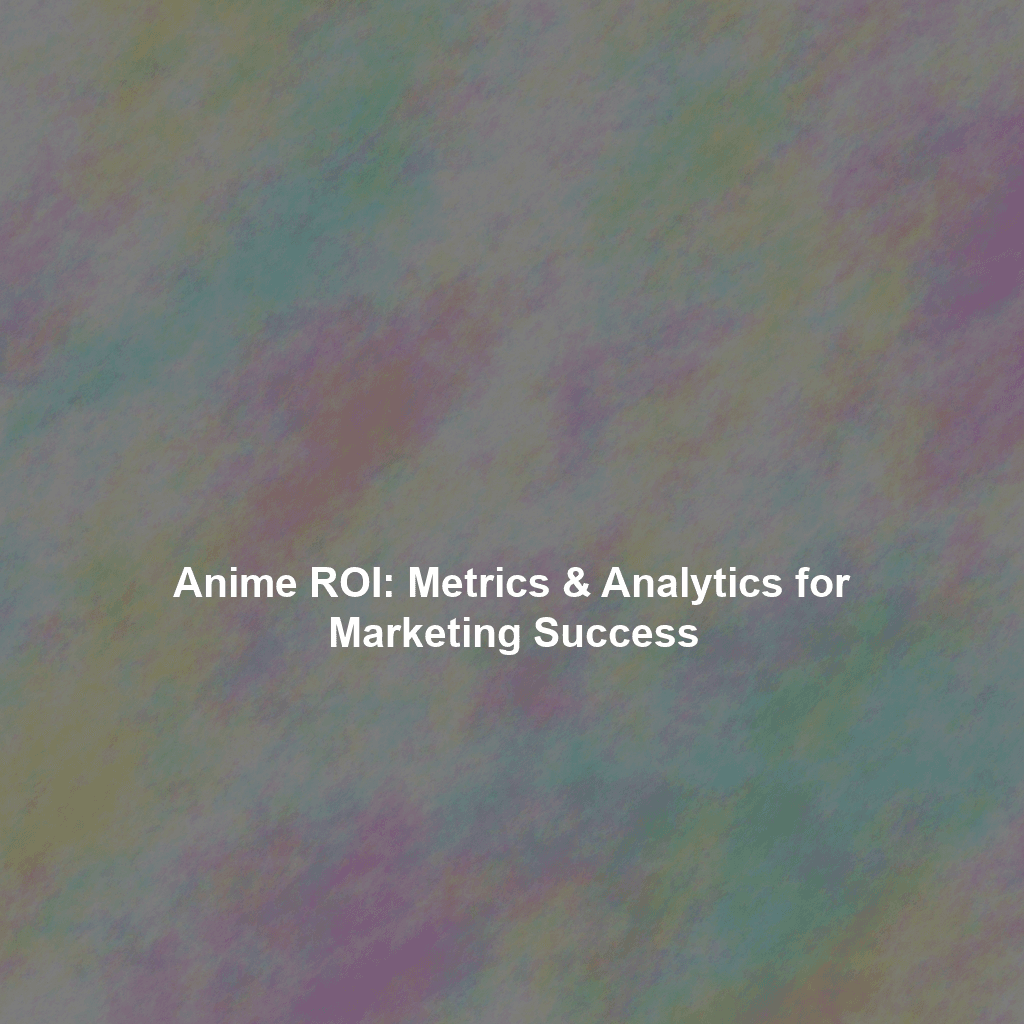Introduction: The Anime Phenomenon and the Need for ROI Measurement
Anime, once a niche interest, has exploded into a global phenomenon. From blockbuster films like Your Name. to globally recognized series like Attack on Titan, anime’s influence is undeniable. This surge in popularity presents a massive opportunity for businesses to tap into a passionate and engaged fanbase. However, simply launching an anime-related marketing campaign isn’t enough. To ensure success and maximize investment, it’s crucial to understand and measure the Return on Investment (ROI) of these campaigns. This article will delve into the key metrics and analytics needed to effectively assess and optimize your anime marketing efforts, drawing on insights from the strategic marketing that propelled anime to its current global status – the very essence of “The ROI of Fandom: How Strategic Marketing Propelled Anime from Niche to Global Phenomenon.”
This article will equip you with the knowledge to:
- Identify key metrics for measuring anime marketing ROI.
- Track brand awareness, engagement, website traffic, social media activity, and sales related to your anime campaigns.
- Utilize data-driven insights to optimize your marketing strategies.
- Maximize your ROI by understanding and leveraging the power of anime fandom.
Understanding the Anime Fandom Landscape
Before diving into metrics, it’s essential to understand the unique characteristics of the anime fandom. Anime fans are known for their:
- Passion and Loyalty: Anime fans are deeply invested in their favorite series and characters, fostering strong brand loyalty.
- Active Online Presence: They are highly active on social media, forums, and online communities, readily sharing their opinions and recommendations.
- Community Engagement: Anime fandom thrives on community, with fans connecting through conventions, cosplay, fan art, and online discussions.
- Diverse Demographics: While often associated with a younger audience, anime appeals to a wide range of age groups, genders, and cultural backgrounds.
Understanding these characteristics is crucial for tailoring your marketing campaigns and selecting the right metrics to measure their effectiveness.
Key Metrics for Measuring Anime Marketing ROI
The ROI of an anime marketing campaign can be measured across various dimensions. Here are some key metrics to consider:
Brand Awareness
Brand awareness measures the extent to which your target audience recognizes your brand. In the context of anime marketing, this involves tracking how well your brand is associated with the anime series, characters, or themes you’re leveraging.
- Social Media Mentions: Track the number of times your brand is mentioned in connection with the anime campaign on platforms like Twitter, Facebook, Instagram, and Reddit. Tools like Mentionlytics and Brand24 can help with this.
- Sentiment Analysis: Analyze the sentiment (positive, negative, or neutral) associated with brand mentions. Positive sentiment indicates successful brand association. Natural Language Processing (NLP) tools can assist with sentiment analysis.
- Website Traffic: Monitor website traffic from sources related to the anime campaign, such as promotional landing pages, anime-related content, or social media links. Use Google Analytics or similar web analytics platforms.
- Search Volume: Track search volume for branded keywords related to the anime campaign. An increase in search volume suggests growing brand awareness. Google Trends is a valuable resource for this.
- Surveys and Polls: Conduct surveys or polls to measure brand recall and recognition among your target audience. Platforms like SurveyMonkey and Google Forms can be used for this purpose.
Example: If a clothing brand collaborates with a popular anime series, tracking mentions of “Brand X + Anime Series Y” on social media and monitoring the sentiment of those mentions will provide insights into brand awareness.
Engagement
Engagement measures the level of interaction and participation from your target audience with your anime marketing campaign. High engagement indicates that your campaign is resonating with the audience.
- Social Media Engagement: Track likes, shares, comments, and saves on social media posts related to the anime campaign. Higher engagement rates indicate a more effective campaign.
- Click-Through Rate (CTR): Measure the CTR of online ads, email campaigns, and social media links related to the anime campaign. A high CTR indicates that your content is compelling and relevant.
- Video Views and Completion Rate: Track video views and completion rates for anime-related video content. Higher views and completion rates suggest that your video content is engaging.
- Comment Sections Activity: Monitor the volume and quality of comments on blog posts, forums, and social media related to the anime campaign. Active and insightful comments indicate a highly engaged audience.
- Contest Participation: Track the number of entries and engagement levels for anime-related contests and giveaways. High participation rates demonstrate strong audience interest.
Example: A game developer collaborating with an anime could track the number of downloads of the game after the collaboration announcement, alongside social media engagement with promotional content.
Website Traffic and Conversions
Website traffic and conversions measure the direct impact of your anime marketing campaign on your website’s performance. Increased traffic and conversions indicate that your campaign is driving valuable leads and sales.
- Website Traffic from Referral Sources: Track website traffic from sources related to the anime campaign, such as social media links, online ads, and partner websites. Use Google Analytics to identify referral sources.
- Landing Page Conversion Rates: Measure the conversion rates of landing pages specifically designed for the anime campaign. Conversion goals can include email sign-ups, product purchases, or demo requests.
- E-commerce Sales Attributed to the Campaign: Track e-commerce sales that can be directly attributed to the anime campaign, using tracking pixels or unique promotional codes.
- Lead Generation: Monitor the number of leads generated through anime-related content, such as webinars, e-books, or case studies.
- Time on Site and Bounce Rate: Analyze the time visitors spend on your website and the bounce rate of landing pages related to the anime campaign. Longer time on site and lower bounce rates suggest that your content is engaging and relevant.
Example: An online retailer selling anime merchandise can track website traffic coming from their anime-themed social media campaigns and correlate it with sales of specific anime-related products.
Sales and Revenue
Ultimately, the ROI of an anime marketing campaign is reflected in the sales and revenue it generates. Tracking sales and revenue provides a clear picture of the campaign’s financial impact.
- Direct Sales of Products or Services: Track the direct sales of products or services related to the anime campaign. This could include merchandise, event tickets, or digital content.
- Subscription Growth: Monitor the growth in subscriptions or memberships attributed to the anime campaign.
- Customer Lifetime Value (CLTV): Analyze the CLTV of customers acquired through the anime campaign. A higher CLTV indicates that the campaign is attracting valuable, long-term customers.
- Return on Ad Spend (ROAS): Calculate the ROAS for paid advertising campaigns related to the anime campaign. ROAS measures the revenue generated for every dollar spent on advertising.
- Overall Revenue Increase: Assess the overall revenue increase during and after the anime campaign. This provides a holistic view of the campaign’s financial impact.
Example: A streaming service can measure the number of new subscribers acquired as a direct result of promoting their anime content library.
Social Media Analytics
Given the importance of social media within the anime fandom, dedicated social media analytics are critical.
- Audience Demographics: Understand the age, gender, location, and interests of your social media followers who are engaging with your anime content. This information can help you tailor future content.
- Reach and Impressions: Track the number of unique users who saw your content (reach) and the total number of times your content was displayed (impressions).
- Share of Voice: Monitor your brand’s share of voice in conversations related to anime within your industry. Tools like Brandwatch can help you measure this.
Tools and Technologies for Tracking Anime Marketing ROI
Several tools and technologies can help you track and analyze the key metrics mentioned above:
- Google Analytics: A powerful web analytics platform for tracking website traffic, user behavior, and conversions. Google Analytics
- Social Media Analytics Platforms: Platforms like Hootsuite, Buffer, and Sprout Social provide comprehensive social media analytics, including engagement rates, reach, and sentiment analysis. Hootsuite, Buffer, Sprout Social
- Social Listening Tools: Tools like Brandwatch, Mention, and Talkwalker help you monitor social media mentions, brand sentiment, and online conversations related to your anime campaign. Brandwatch, Mention, Talkwalker
- CRM Systems: Customer Relationship Management (CRM) systems like Salesforce and HubSpot help you track leads, manage customer interactions, and measure the ROI of your marketing campaigns. Salesforce, HubSpot
- Marketing Automation Platforms: Platforms like Marketo and Pardot help you automate marketing tasks, track email performance, and personalize customer experiences.
Data-Driven Insights for Optimizing Anime Marketing Strategies
Collecting data is only the first step. The real value lies in analyzing the data and using the insights to optimize your anime marketing strategies. Here are some examples:
- Refine Targeting: Use demographic and interest data from social media analytics to refine your targeting and reach the most relevant audience.
- Optimize Content: Analyze engagement rates and sentiment analysis to identify the types of content that resonate most with your audience.
- Improve Landing Pages: Use A/B testing to optimize landing page design and messaging to improve conversion rates.
- Adjust Ad Spend: Allocate your ad budget to the channels and campaigns that are generating the highest ROAS.
- Personalize Customer Experiences: Use CRM data to personalize customer interactions and provide targeted offers based on their interests and preferences.
For instance, if you find that video content featuring a specific anime character consistently generates high engagement, you can create more content featuring that character or tailor your messaging to appeal to fans of that character.
Case Studies: Successful Anime Marketing Campaigns and Their ROI
Analyzing successful anime marketing campaigns can provide valuable insights into best practices and potential ROI. Here are a few examples:
- Crunchyroll and [Various Partnerships]: Crunchyroll, a leading anime streaming service, has partnered with various brands to create co-branded content and experiences. These partnerships have helped to expand Crunchyroll’s reach and increase brand awareness among anime fans. (Note: Specific quantifiable ROI data for these partnerships is often proprietary, but their continued prevalence suggests success).
- [Hypothetical Example] Mobile Game and Anime Collaboration: A popular mobile game collaborates with a trending anime series, introducing limited-edition characters and story arcs from the anime into the game. By tracking in-app purchases, new user acquisition, and social media engagement, the game developer can measure the ROI of the collaboration. If the collaboration results in a significant increase in revenue and user activity, it would be considered a successful campaign.
By studying these case studies and similar successful campaigns, marketers can gain a better understanding of how to leverage anime fandom to achieve their business goals. Always look for press releases and industry reports that, while they might not contain hard ROI numbers, often hint at the level of success achieved.
The Future of Anime Marketing and ROI Measurement
As anime continues to gain global popularity, the future of anime marketing will be shaped by several key trends:
- Increased Personalization: Marketers will leverage data-driven insights to create more personalized and relevant experiences for anime fans.
- Integration with Emerging Technologies: Anime marketing will increasingly incorporate emerging technologies such as augmented reality (AR), virtual reality (VR), and blockchain.
- Emphasis on Authenticity: Brands will need to demonstrate authenticity and a genuine understanding of anime culture to resonate with fans.
- Sophisticated ROI Measurement: As marketing strategies become more complex, the need for sophisticated ROI measurement techniques will grow.
To stay ahead of the curve, marketers should continuously adapt their strategies and embrace new technologies to effectively engage with anime fans and maximize their ROI.
Conclusion: Harnessing the Power of Anime Fandom for Marketing Success
Measuring the ROI of anime marketing campaigns is essential for ensuring that your investments are paying off. By tracking key metrics, analyzing data-driven insights, and optimizing your strategies, you can harness the power of anime fandom to achieve your business goals. Remember to focus on authenticity, personalization, and community engagement to build strong relationships with anime fans and drive long-term success. Understanding the core principles outlined in “The ROI of Fandom: How Strategic Marketing Propelled Anime from Niche to Global Phenomenon” will be crucial for navigating this dynamic landscape.
 Skip to content
Skip to content

